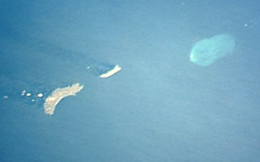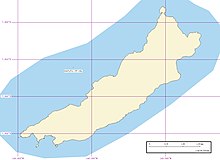Hatutu
 Image of northwestern Marquesas Islands. Hatutu is the center island.Image courtesy ofJohnson Space Center. | |
| Geography | |
|---|---|
| Location | South Pacific Ocean |
| Coordinates | 7°55′S140°34′W/ 7.92°S 140.57°W |
| Archipelago | Marquesas Islands |
| Area | 18.1 km2(7.0 sq mi) |
| Highest elevation | 428 m (1404 ft) |
| Administration | |
| Overseas country | French Polynesia |
| Demographics | |
| Population | 0[1](2017) |
| Pop. density | 0/km2(0/sq mi) |
Hatutu(also calledHatuta‘a) is a small island approximately 3 km (2 mi.) northeast ofEiaoin the northernMarquesas Islands.It is approximately 3 km (2 mi) from Eiao by a channel 50 meters deep. It was also known by the names Hancock, Chanal, Langdon, and Nexsen
Hatutu is administratively part of thecommune(municipality) ofNuku-Hiva,itself in theadministrative subdivisionof theMarquesas Islands.
It consists of a high central ridge, which runs the full 6.5 km (4 mi.) length of the island. The ridge rises to heights up to 428 m (1,404 ft.) abovesea level.[2]Its only anchorage point is in the south of the island for small ships.

The island was discovered by an American named Joseph Ingraham in April of 1791, then again two months later by a Frenchman known as Étienne Marchand. There have never been permanent settlement on the island, however in 1798 Edmund Fanning reported seeing smoke plumes, suggesting temporary settlement by native people.[3]In 1992, Hatutu was declared anature reserve:theHatutu Nature Reserve.
The island is an important nesting ground forred-footed booby,black noddy,white tern,great frigatebird,andmasked booby,and home to the endemicnorthern Marquesan reed warblerand theMarquesan ground dove.It is also the largest breeding site ofPhoenix PetrelinFrench PolynesiaMany native seabirds come to nest on the island throughout the year. The island is also plagued byPolynesian rat(Rattus exulens) a species introduced by humans sometime in the last several hundred years. The rats likely prey upon native animals and plants potentially changing the ecosystem dynamic on the island.
See also
[edit]References
[edit]- ^"Répartition de la population en Polynésie française en 2017"(PDF).Institut de la statistique de la Polynésie française. p. 10. Archived fromthe original(PDF)on 13 November 2018.
- ^"Hatutu".DIREN. Archived fromthe originalon 5 June 2013.
- ^"Early Observations of Marquesan Culture, 1595–1813".UAPress.2017-07-12.Retrieved2024-06-24.
